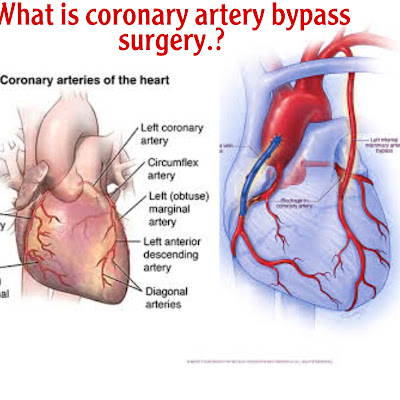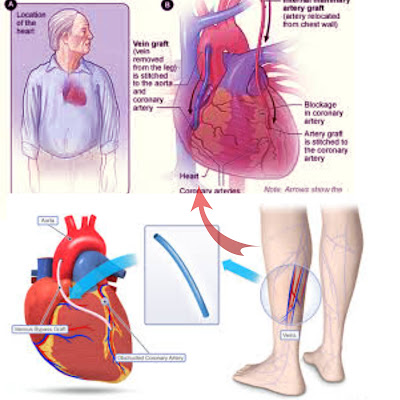What is coronary detour unite a medical procedure?
Coronary vein sidestep unite a medical procedure (CABG) is a strategy used to treat coronary course illness. Coronary corridor illness (CAD) is the limiting of the ..
One method for treating the impeded or restricted corridors is to sidestep the hindered part of the coronary course with a piece of a solid vein from somewhere else in your body. Veins, or unites, utilized for the detour method might be bits of a vein from your leg or a corridor in your chest. A vein from your wrist may likewise be utilized. Your PCP appends one finish of the join over the blockage and the opposite end beneath the blockage. Blood sidesteps the blockage by going through the new unite to arrive at the heart muscle. This is called coronary supply route sidestep a medical procedure.
Generally, to sidestep the obstructed coronary vein, your PCP makes a huge cut in the chest and briefly stops the heart. To open the chest, your primary care physician cuts the breastbone (sternum) in half longwise and spreads it separated. When the heart is uncovered, your PCP embeds tubes into the heart so the blood can be siphoned through the body by a heart-lung sidestep machine. The detour machine is important to siphon blood while the heart is halted.
While the conventional "open heart" system is still usually done and frequently liked generally speaking, less obtrusive methods have been created to sidestep impeded coronary veins. "Off-siphon" strategies, in which the heart doesn't need to be halted, were created in the 1990's. Other negligibly obtrusive systems, like keyhole medical procedure (done through tiny cuts) and automated methodology (finished with the guide of a moving mechanical gadget), might be utilized.
For what reason could I want coronary vein sidestep a medical procedure?
Your primary care physician utilizes coronary vein sidestep unite a medical procedure (CABG) to treat a blockage or limiting of at least one of the coronary courses to reestablish the blood supply to your heart muscle.
Side effects of coronary vein illness might include:
• Chest torment
• Weakness (serious sleepiness)
• Palpitations
• Strange heart rhythms
• Windedness
• Enlarging in the hands and feet
• Heartburn
Tragically, you might not have any side effects in early coronary conduit illness, yet the sickness will keep on advancing until there's sufficient vein blockage to cause side effects and issues. On the off chance that the blood supply to your heart muscle keeps on diminishing because of expanding blockage of a coronary corridor, you might have a respiratory failure. On the off chance that the blood stream can't be reestablished to the specific region of the heart muscle impacted, the tissue kicks the bucket.
There might be different explanations behind your primary care physician to suggest CABG medical procedure.
What are the dangers of coronary vein sidestep a medical procedure?
Potential dangers of coronary supply route sidestep unite a medical procedure (CABG) include:
• Draining during or after the medical procedure
• Blood clumps that can cause coronary episode, stroke, or lung issues
• Contamination at the entry point site
• Pneumonia
• Breathing issues
• Pancreatitis
• Kidney disappointment
• Unusual heart rhythms
• Disappointment of the unite
• Demise
There might be different dangers relying upon your particular ailment. Make certain to examine any worries with your primary care physician before the system.
How would I prepare for coronary corridor sidestep a medical procedure?
• Your PCP will make sense of the method and you can clarify some pressing issues.
• You will be approached to sign an assent structure that gives your consent to do the test. Peruse the structure cautiously and clarify some pressing issues on the off chance that anything is muddled.
• Alongside a survey of your wellbeing history, your PCP will do a total actual test to ensure you are in any case great wellbeing prior to having the methodology. You might require blood tests or other demonstrative tests.
• You will be approached to not eat or drink for 8 hours before the method, for the most part after 12 PM.
• You might be approached to shower with a cleanser or exceptional chemical the prior night and the morning of medical procedure.
• Let your primary care physician know if you are pregnant or figure you could be.
• Let your PCP know if you are delicate to or are sensitive to any medications, iodine, plastic, tape, or sedative meds (nearby and general).
• Inform your PCP regarding all meds (solution and over-the-counter), nutrients, spices, and enhancements that you are taking.
• Let your primary care physician know if you have a background marked by draining issues or on the other hand assuming you are taking any blood-diminishing medications, ibuprofen, or different prescriptions that influence blood thickening. You might be told to stop a portion of these drugs before the system.
• Your PCP might do blood tests before the system to figure out what amount of time it requires for your blood to cluster.
• Let your PCP know if you have a pacemaker or some other embedded cardiovascular gadget.
• On the off chance that you smoke, quit smoking at the earliest opportunity. This will work on your opportunities for an effective recuperation from medical procedure and advantage your general wellbeing.
• In light of your ailment, your primary care physician might request that you do different things to prepare.
What occurs during coronary supply route sidestep?
Coronary vein sidestep join a medical procedure (CABG) requires a stay in a clinic. Strategy might shift relying upon your condition and your PCP's practices.
For the most part, CABG follows this cycle:
1. You will be approached to eliminate any gems or different articles that might slow down the method.
2. You will change into an emergency clinic outfit and void your bladder.
3. You will lie on your back on a surgical table.
4. The anesthesiologist will ceaselessly screen your pulse, circulatory strain, breathing, and blood oxygen level during the medical procedure. Whenever you are calmed (put into a profound rest), a breathing cylinder will be placed into your throat and you will be associated with a ventilator, which will relax for you during the medical procedure.
5. A medical care proficient will embed an intravenous (IV) line in your arm or hand. Different catheters will be placed in your neck and wrist to screen your heart and pulse, as well as to take blood tests.
6. A catheter will be placed into your bladder to deplete pee.
7. The skin over the careful site will be cleaned with a germ-free arrangement.
8. Once every one of the cylinders and screens are set up, your primary care physician will make entry points (cuts) in either of your legs or one of your wrists to get to the blood vessel(s) to be utilized for the unions. The person will eliminate the vessel(s) and close those incision(s).
9. The specialist will make an entry point (cut) underneath the Adam's apple to simply over the navel.
10. The specialist will cut the sternum (breastbone) in half the long way. The person in question will isolate the parts of the breastbone and spread them separated to uncover your heart.
Coronary corridor sidestep join a medical procedure - on-siphon methodology
1. To sew the unions onto the tiny coronary supply routes, your PCP should stop your heart for a brief time. Cylinders will be placed into the heart so your blood can be siphoned through your body by a heart-lung sidestep machine.
2. Once the blood has been redirected into the detour machine for siphoning, your PCP will stop the heart by infusing it with a chilly arrangement.
3. When the heart has been halted, the specialist will do the detour unite method by sewing one finish of a part of vein over a small opening made in the aorta, and the opposite end over a little opening made in the coronary course beneath the blockage. In the event that your primary care physician involves the inside mammary corridor inside your chest as a detour join, the lower end of the conduit will be cut from inside the chest and sewn over an opening made in the coronary vein underneath the blockage.
4. You may require more than one detour unite done, contingent upon the number of blockages you that have and where they are found. After every one of the unions have been finished, the specialist will intently check them as blood goes through them to ensure they are working.
5. Once the detour joins have been checked, the specialist will let the blood flowing through the detour machine once more into your heart and the individual in question will eliminate the cylinders to the machine. Your heart might restart all alone, or a gentle electric shock might be utilized to restart it.
6. Your specialist might place brief wires for pacing into your heart. These wires can be connected to a pacemaker and your heart can be paced, if necessary, during the underlying recuperation time frame.
Coronary supply route sidestep a medical procedure - off-siphon technique
1. Once your primary care physician has opened the chest, the person in question will settle the region around the supply route to be circumvent with an exceptional instrument.
2. The rest of the heart will proceed to capacity and siphon blood through the body.
3. The heart-lung sidestep machine and the individual who runs it very well might be kept ready and waiting in the event the methodology should be finished on sidestep.
4. The specialist will do the detour unite methodology by sewing one finish of a segment of vein over a little opening made in the aorta, and the opposite end over a small opening made in the coronary corridor just beneath the blockage.
5. You may have more than one detour unite done, contingent upon the number of blockages you that have and where they are found.
6. Before the chest is shut, the specialist will intently analyze the unions to ensure they are working.
Technique fruition, the two strategies
1. Your specialist will sew the sternum along with little wires (like those occasionally used to fix a messed up bone).
2. He or she will embed tubes into your chest to empty blood and different liquids out of around the heart.
3. Your specialist will sew the skin over the sternum back together.
4. Your specialist will place a cylinder through your mouth or nose into your stomach to deplete stomach liquids.
5. He or she will then apply a sterile wrap or dressing.
What occurs after coronary conduit sidestep a medical procedure?
In the clinic
After the medical procedure, you will be taken to the emergency unit to be firmly checked. Machines will continually..




.jpg)

0 Comments
Well come to Health net career.